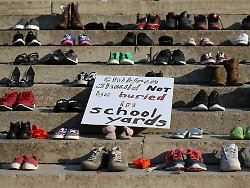Saturday 31 July 2021
“Cultural Genocide”
Bone finds shake Canada
In addition to Corona, Canada has had one main topic since the end of May – the conditions in the re-education boarding schools for daughters and sons of indigenous people. The systematic search always finds new remains of children who did not survive the terrible circumstances there.
When the remains of more than 200 Aboriginal children were discovered at a former boarding school in western Canada in late May, Crystal Fraser was not surprised. “We have known for decades, even more than a century, that many of our ancestors and immediate family members did not come home from boarding schools,” she says. Fraser is a historian at the University of Alberta and also a member of the Gwichyà Gwich’in indigenous group.
But what she saw coming is shaking up large parts of Canada these days: the bones of over 1,000 people have been found in the vicinity of former institutions since the end of May through the use of new technology. These boarding schools for Native American daughters and sons were designed to “kill the Indian in the child,” as Fraser puts it. Canada, considered cosmopolitan, had long ignored its dark history. Now the bone finds are also increasing the pressure on Ottawa.
Boarding schools in Canada existed for more than 100 years. They began with the first school of the Franciscan order in the 17th century. However, a system did not come into existence until the Canadian Federation was founded in 1867 – the Truth and Reconciliation Commission set up by the government in 2008 counted 139 schools that indigenous children were forced to attend. The last ones closed in 1996, affecting an estimated 150,000 children.
Many dead
“We now know that it was a system of genocide,” explains expert Fraser. Physical and sexual abuse were commonplace in church-run institutions. Among other things, the children were beaten for talking in their language. The Truth and Reconciliation Commission called the procedure “cultural genocide” in its final report.
According to Fraser, the Canadian settlers had tried to use the system to incorporate the free indigenous peoples, to impose heteronormative ideas, language and capitalism on them. Brutal treatment and overcrowding of the institutions led to many deaths: The students died of diseases, malnutrition or accidents, for example with broken agricultural equipment.
“I wouldn’t be surprised that if you searched the grounds of every boarding school in Canada, the death toll could be in the tens of thousands,” Fraser continued. The death rate in some institutions has been up to 70 percent in certain years. New radar technology is now being used to search for unmarked graves all over the country on former school grounds.
No recognition so far
So far, more than 1,500 dead have been found in several Canadian provinces – and each new discovery sends shock waves across the country. “I know these discoveries only add to the pain families, survivors and all indigenous peoples and communities are already feeling,” said Prime Minister Justin Trudeau. But while the prime minister tried to calm down, others reacted with open anger.
Several churches on the land of indigenous groups were set on fire or devastated. Trudeau – himself a Catholic – condemned the violence, but also expressed himself understandingly: The anger was “real and completely understandable in view of the shameful history of which we are all becoming more aware”. In a more symbolic step, he also made Mary Simon the first indigenous peoples to be governor general – and thus the representative of Queen Elizabeth II as head of state.
Trudeau also acts as an election campaigner: The outcome of early elections that may take place soon could also depend on how well he does with the indigenous people. Their great hope for real recognition has long been disappointed. Many indigenous people say they do not feel a strong connection with the land in which they live. “To be honest, I don’t call myself Canadian,” says Crystal Fraser.
Life not lived
While critics accuse Trudeau of failing to follow up on his election promise of comprehensive reconciliation, the prime minister also targeted the Vatican: Pope Francis should travel to Canada and apologize to the indigenous people, he demanded. The head of the church himself called the findings “harrowing” and said: “May the political and religious authorities in Canada continue to work together with determination to shed light on this sad event”.
There was initially no comment on the status of the investigation by the Catholic Church and the role of the Vatican in the investigation. In December the Pope is to receive a delegation of indigenous people from Canada, including survivors from the boarding schools.
Meanwhile, Crystal Fraser speaks of her grief over what could have been if the children hadn’t died – about lives that were never lived. One of them was that of her great aunt, who died of an illness in one of the institutions. “As far as I know, her body was never recovered,” said Fraser. But the radar investigations would also be carried out at this boarding school at some point. It just seems like a matter of time.
.
